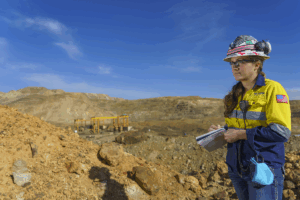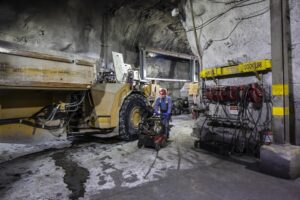Bring Hands-On Mining Into Your Classroom
 The Nevada Mining Association has partnered with the American Geosciences Institute to update select lessons, aligning them with state standards and connecting them to real-world examples. Topics include rocks and minerals, the mining process, sustainability, map reading, and plate tectonics.
The Nevada Mining Association has partnered with the American Geosciences Institute to update select lessons, aligning them with state standards and connecting them to real-world examples. Topics include rocks and minerals, the mining process, sustainability, map reading, and plate tectonics.
If you have any questions regarding these activities or future teacher workshops, please contact us or call us at (775) 829-2121.
What’s New
- Grade-Level Specific – Each topic has different versions for students in grades 3-5, middle school, and high school, ensuring age-appropriate content and activities. Most topics also have lessons for students in grades K-2.
- Aligned with NVACSS and the Employability Skills for Career Readiness standards – Each lesson is aligned with Nevada Earth Science and Career state standards that integrates science and engineering practices, crosscutting concepts, and disciplinary core ideas, with mining topics as context for learning earth science concepts.
- Real-World Applications – Students engage with Nevada-specific samples and maps to explore Earth processes, resource formation, and human-environment interactions within the state’s unique landscape.
- Interactive Resources – Lessons incorporate digital mapping tools, hands-on modeling activities, and interactive investigations to enhance student learning.
- Teacher Support – Each lesson includes detailed preparation steps, discussion questions, and instructional guidance to make implementation easy.
While these lessons are aligned with Nevada-specific standards and feature Nevada-specific maps, samples, data, and examples, they can be adapted for use in any location. The Nevada Academic Content Standards for Science (NVACSS) are aligned with the Next Generation Science Standards (NGSS).
Minerals and Rocks
 These lessons explore the properties, identification, and formation of rocks and minerals, with activities tailored to different grade levels. Depending on the lesson, students may conduct hands-on tests, analyze geological data, explore the rock cycle, or investigate critical minerals. Some focus on local geology and real-world applications, while others emphasize scientific testing and classification.
These lessons explore the properties, identification, and formation of rocks and minerals, with activities tailored to different grade levels. Depending on the lesson, students may conduct hands-on tests, analyze geological data, explore the rock cycle, or investigate critical minerals. Some focus on local geology and real-world applications, while others emphasize scientific testing and classification.
Browse the teacher guide below for your grade level!
The Mining Process
 These lessons introduce students to the mining process and its environmental implications through hands-on activities and real-world examples. Depending on the lesson, students may analyze mineral and rock waste, model the mining process, assess the costs and benefits of mining, or explore land reclamation efforts. Some lessons emphasize the impact of mining on landscapes, while others focus on resource extraction.
These lessons introduce students to the mining process and its environmental implications through hands-on activities and real-world examples. Depending on the lesson, students may analyze mineral and rock waste, model the mining process, assess the costs and benefits of mining, or explore land reclamation efforts. Some lessons emphasize the impact of mining on landscapes, while others focus on resource extraction.
Browse the teacher guide below for your grade level!
Sustainability and Mining
 These lessons examine how mining relates to sustainability and environmental impact through hands-on activities, models, and real-world examples. Students explore mineral use, site changes, and the balance between resource extraction and environmental responsibility, with some lessons highlighting the UN Sustainable Development Goals and mine reclamation efforts.
These lessons examine how mining relates to sustainability and environmental impact through hands-on activities, models, and real-world examples. Students explore mineral use, site changes, and the balance between resource extraction and environmental responsibility, with some lessons highlighting the UN Sustainable Development Goals and mine reclamation efforts.
Browse the teacher guide below for your grade level!
Map Reading
 These lessons build map-reading skills and explore the connections between Earth’s processes and human activity. Depending on the lesson, students may analyze topographic and/or geologic maps, create models, examine how topographic maps have changed over time, or investigate resource distribution. Some focus on local geography, while others emphasize mapping techniques and landscape analysis.
These lessons build map-reading skills and explore the connections between Earth’s processes and human activity. Depending on the lesson, students may analyze topographic and/or geologic maps, create models, examine how topographic maps have changed over time, or investigate resource distribution. Some focus on local geography, while others emphasize mapping techniques and landscape analysis.
Browse the teacher guide below for your grade level!
Plate Tectonics
 These lessons connect plate tectonics, fault movement, and mineral formation, helping students explore how geologic processes shape landscapes and resource distribution. Depending on the lesson, students may model fault movement, analyze maps of Nevada’s landforms and mineral deposits, or investigate how tectonic forces influence resource formation. Some lessons focus on earthquake activity and land changes, while others examine mineral deposits linked to geologic history.
These lessons connect plate tectonics, fault movement, and mineral formation, helping students explore how geologic processes shape landscapes and resource distribution. Depending on the lesson, students may model fault movement, analyze maps of Nevada’s landforms and mineral deposits, or investigate how tectonic forces influence resource formation. Some lessons focus on earthquake activity and land changes, while others examine mineral deposits linked to geologic history.
Browse the teacher guide below for your grade level!
